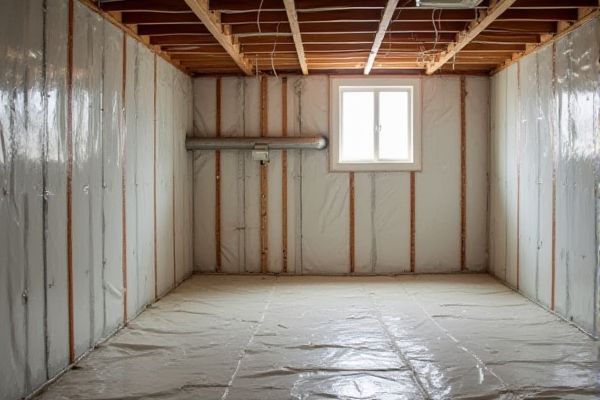
A vapor barrier prevents moisture vapor from passing through walls or floors, while a moisture barrier blocks liquid water from entering your basement. Understanding the differences between these barriers is crucial for effective basement waterproofing--read on to learn how to protect your home properly.
Table of Comparison
| Feature | Vapor Barrier | Moisture Barrier |
|---|---|---|
| Purpose | Blocks water vapor diffusion | Prevents liquid water infiltration |
| Material | Polyethylene sheets (6-mil or thicker) | Thick plastic membranes or rubberized coatings |
| Installation Location | Interior basement walls and floors | Exterior foundation walls and footings |
| Function | Limits condensation and mold growth | Stops groundwater and rainwater intrusion |
| Permeability | Very low permeability to water vapor | Impermeable to liquid water |
| Typical Use | Indoor moisture control in basements | Exterior waterproofing of foundation |
| Effectiveness | Reduces humidity and vapor damage | Prevents structural water damage |
Understanding Vapor Barriers and Moisture Barriers
Vapor barriers and moisture barriers serve distinct functions in basement waterproofing by controlling the movement of water and water vapor. Vapor barriers primarily block water vapor diffusion from humid air to prevent condensation, while moisture barriers stop liquid water penetration from soil or leaks. Understanding these differences ensures your basement stays dry and protected from mold and structural damage.
Key Differences Between Vapor Barriers and Moisture Barriers
Vapor barriers primarily control water vapor transmission to prevent condensation within basement walls, while moisture barriers are designed to block liquid water intrusion from external sources such as groundwater. Vapor barriers are typically made from materials like polyethylene sheets with low permeability, whereas moisture barriers may include membranes, coatings, or sealants that physically resist water penetration. Understanding these distinctions is crucial for effective basement waterproofing and maintaining structural integrity.
How Moisture Enters Basement Spaces
Moisture enters basement spaces primarily through soil vapor transmission, surface water infiltration, and groundwater seepage, requiring effective vapor barriers to block water vapor diffusion and moisture barriers to prevent liquid water penetration. Vapor barriers, typically made of polyethylene sheeting, control water vapor movement from the soil into the basement air, while moisture barriers focus on sealing cracks and drainage issues to stop actual water flow. Proper installation of both barriers ensures reduced humidity levels, prevents mold growth, and protects basement structural integrity.
Importance of Proper Basement Waterproofing
Proper basement waterproofing relies on the effective installation of vapor barriers and moisture barriers to prevent water infiltration and reduce humidity levels. Vapor barriers control the passage of water vapor, minimizing condensation and mold growth, while moisture barriers block liquid water from penetrating foundation walls and floors. Selecting the right barrier based on basement conditions ensures structural integrity and maintains a healthy indoor environment.
Types of Vapor Barriers for Basements
Polyethylene sheets, typically 6-mil or thicker, serve as common vapor barriers for basements, preventing water vapor from penetrating foundation walls and floors. Foil-faced insulation and spray-applied membranes offer alternative vapor barrier types with enhanced durability and adhesion capabilities. Proper selection depends on basement conditions, with rigid foam board and liquid-applied barriers providing effective moisture control and improved energy efficiency in varying climates.
Moisture Barrier Materials and Options
Moisture barrier materials for basements typically include polyethylene sheets, rubberized asphalt membranes, and liquid-applied coatings designed to prevent water ingress and control humidity levels. Polyethylene vapor barriers are popular due to their low cost and effectiveness in blocking water vapor transmission. Specialized membranes with self-adhesive properties enhance durability by sealing seams and cracks, offering long-term protection against basement moisture problems.
Installation Techniques: Vapor Barrier vs Moisture Barrier
Installing a vapor barrier in your basement typically involves laying polyethylene sheets directly on the floor or walls to prevent moisture vapor from penetrating living spaces, while moisture barriers require more comprehensive sealing using membranes or coatings that block liquid water infiltration. Vapor barriers are best installed beneath flooring or wall finishes to manage humidity levels, whereas moisture barriers need meticulous application around foundation cracks and seams to protect against bulk water intrusion. Proper installation of either barrier is crucial for maintaining basement dryness and preventing mold, with vapor barriers focusing on vapor diffusion control and moisture barriers emphasizing physical water resistance.
Common Mistakes in Basement Barrier Applications
Common mistakes in basement vapor barrier applications include incorrect installation such as placing the barrier on the wrong side of the insulation, which traps moisture within wall cavities and fosters mold growth. Using vapor barriers instead of moisture barriers in areas below grade can lead to water infiltration issues since vapor barriers are not designed to block liquid water. Failing to properly seal seams and penetrations creates pathways for moisture, undermining the barrier's effectiveness and compromising basement air quality.
Choosing the Right Barrier for Your Basement
Selecting the right barrier for your basement depends on its specific moisture challenges, where vapor barriers primarily control water vapor diffusion, and moisture barriers block liquid water penetration. Concrete or polyethylene sheets with high perm ratings serve well as vapor barriers, while thicker, more durable membranes are effective moisture barriers against groundwater and flooding. Evaluating basement humidity levels, drainage systems, and local climate ensures optimal protection and prevents mold growth and structural damage.
Maintenance and Longevity of Basement Barriers
Vapor barriers in basements require regular inspection to prevent punctures and ensure long-term moisture control, significantly extending the lifespan of walls and floors. Moisture barriers, often thicker and more durable, provide enhanced resistance to water infiltration but demand proper installation and occasional upkeep to maintain effectiveness. Choosing a high-quality barrier and addressing any damage promptly can maximize the durability and protective function of basement moisture management systems.
 homyna.com
homyna.com